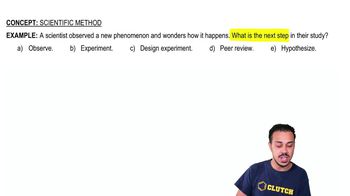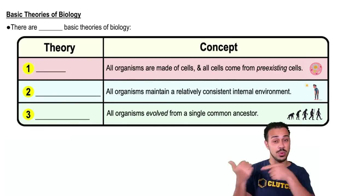Table of contents
- 1. Introduction to Biology2h 42m
- 2. Chemistry3h 40m
- 3. Water1h 26m
- 4. Biomolecules2h 23m
- 5. Cell Components2h 26m
- 6. The Membrane2h 31m
- 7. Energy and Metabolism2h 0m
- 8. Respiration2h 40m
- 9. Photosynthesis2h 49m
- 10. Cell Signaling59m
- 11. Cell Division2h 47m
- 12. Meiosis2h 0m
- 13. Mendelian Genetics4h 44m
- Introduction to Mendel's Experiments7m
- Genotype vs. Phenotype17m
- Punnett Squares13m
- Mendel's Experiments26m
- Mendel's Laws18m
- Monohybrid Crosses19m
- Test Crosses14m
- Dihybrid Crosses20m
- Punnett Square Probability26m
- Incomplete Dominance vs. Codominance20m
- Epistasis7m
- Non-Mendelian Genetics12m
- Pedigrees6m
- Autosomal Inheritance21m
- Sex-Linked Inheritance43m
- X-Inactivation9m
- 14. DNA Synthesis2h 27m
- 15. Gene Expression3h 20m
- 16. Regulation of Expression3h 31m
- Introduction to Regulation of Gene Expression13m
- Prokaryotic Gene Regulation via Operons27m
- The Lac Operon21m
- Glucose's Impact on Lac Operon25m
- The Trp Operon20m
- Review of the Lac Operon & Trp Operon11m
- Introduction to Eukaryotic Gene Regulation9m
- Eukaryotic Chromatin Modifications16m
- Eukaryotic Transcriptional Control22m
- Eukaryotic Post-Transcriptional Regulation28m
- Eukaryotic Post-Translational Regulation13m
- 17. Viruses37m
- 18. Biotechnology2h 58m
- 19. Genomics17m
- 20. Development1h 5m
- 21. Evolution3h 1m
- 22. Evolution of Populations3h 52m
- 23. Speciation1h 37m
- 24. History of Life on Earth2h 6m
- 25. Phylogeny2h 31m
- 26. Prokaryotes4h 59m
- 27. Protists1h 12m
- 28. Plants1h 22m
- 29. Fungi36m
- 30. Overview of Animals34m
- 31. Invertebrates1h 2m
- 32. Vertebrates50m
- 33. Plant Anatomy1h 3m
- 34. Vascular Plant Transport1h 2m
- 35. Soil37m
- 36. Plant Reproduction47m
- 37. Plant Sensation and Response1h 9m
- 38. Animal Form and Function1h 19m
- 39. Digestive System1h 10m
- 40. Circulatory System1h 57m
- 41. Immune System1h 12m
- 42. Osmoregulation and Excretion50m
- 43. Endocrine System1h 4m
- 44. Animal Reproduction1h 2m
- 45. Nervous System1h 55m
- 46. Sensory Systems46m
- 47. Muscle Systems23m
- 48. Ecology3h 11m
- Introduction to Ecology20m
- Biogeography14m
- Earth's Climate Patterns50m
- Introduction to Terrestrial Biomes10m
- Terrestrial Biomes: Near Equator13m
- Terrestrial Biomes: Temperate Regions10m
- Terrestrial Biomes: Northern Regions15m
- Introduction to Aquatic Biomes27m
- Freshwater Aquatic Biomes14m
- Marine Aquatic Biomes13m
- 49. Animal Behavior28m
- 50. Population Ecology3h 41m
- Introduction to Population Ecology28m
- Population Sampling Methods23m
- Life History12m
- Population Demography17m
- Factors Limiting Population Growth14m
- Introduction to Population Growth Models22m
- Linear Population Growth6m
- Exponential Population Growth29m
- Logistic Population Growth32m
- r/K Selection10m
- The Human Population22m
- 51. Community Ecology2h 46m
- Introduction to Community Ecology2m
- Introduction to Community Interactions9m
- Community Interactions: Competition (-/-)38m
- Community Interactions: Exploitation (+/-)23m
- Community Interactions: Mutualism (+/+) & Commensalism (+/0)9m
- Community Structure35m
- Community Dynamics26m
- Geographic Impact on Communities21m
- 52. Ecosystems2h 36m
- 53. Conservation Biology24m
1. Introduction to Biology
Scientific Method
Problem 5`
Textbook Question
One hypothesis states that eating chicken noodle soup is an effective treatment for colds. Which of the following results does this hypothesis predict?
a. People who eat chicken noodle soup have shorter colds than do people who do not eat chicken noodle soup.
b. People who do not eat chicken noodle soup experience unusually long and severe colds.
c. Cold viruses cannot live in chicken noodle soup.
d. People who eat chicken noodle soup feel healthier than do people who do not eat chicken noodle soup.
e. Consuming chicken noodle soup causes people to sneeze.
 Verified step by step guidance
Verified step by step guidance1
Step 1: Understand the concept of a hypothesis. A hypothesis is a testable statement that predicts a relationship between variables. In this case, the hypothesis is that eating chicken noodle soup is an effective treatment for colds.
Step 2: Analyze the options provided. Each option represents a potential prediction that could be derived from the hypothesis. The correct prediction should align with the idea that chicken noodle soup helps treat colds.
Step 3: Evaluate each option:
- Option a suggests that people who eat chicken noodle soup recover faster, which directly supports the hypothesis.
- Option b implies unusually severe colds for those who do not eat soup, which is not a direct prediction of the hypothesis.
- Option c states that cold viruses cannot survive in soup, which is unrelated to the treatment aspect.
- Option d suggests feeling healthier, which is subjective and not necessarily tied to the treatment of colds.
- Option e mentions sneezing, which is unrelated to the hypothesis.
Step 4: Determine which option best aligns with the hypothesis. The hypothesis predicts an effective treatment, so the correct answer should focus on measurable improvement in cold symptoms or duration.
Step 5: Conclude that the most logical prediction is the one that directly supports the hypothesis by showing a measurable benefit of eating chicken noodle soup in treating colds.
 Verified video answer for a similar problem:
Verified video answer for a similar problem:This video solution was recommended by our tutors as helpful for the problem above
Video duration:
59sPlay a video:
Was this helpful?
Key Concepts
Here are the essential concepts you must grasp in order to answer the question correctly.
Hypothesis Testing
Hypothesis testing is a statistical method used to determine the validity of a proposed explanation for a phenomenon. In this context, the hypothesis suggests that chicken noodle soup has a beneficial effect on the duration or severity of colds. To evaluate this hypothesis, one would look for evidence that supports or contradicts the predicted outcomes based on the consumption of chicken noodle soup.
Recommended video:
Guided course

Test Crosses
Causation vs. Correlation
Causation refers to a direct cause-and-effect relationship between two variables, while correlation indicates a relationship without implying direct causation. In the context of the hypothesis, it is important to distinguish whether eating chicken noodle soup directly causes shorter colds or if there is merely a correlation between soup consumption and cold duration due to other factors.
Recommended video:
Guided course

Dominant vs. Recessive Alleles
Control Groups
Control groups are essential in experimental design as they provide a baseline for comparison against the experimental group. In testing the hypothesis about chicken noodle soup, a control group that does not consume the soup would help determine if any observed differences in cold duration or severity are indeed due to the soup or other variables, ensuring the reliability of the results.
Recommended video:
Guided course

Functional Groups
Related Videos
Related Practice














